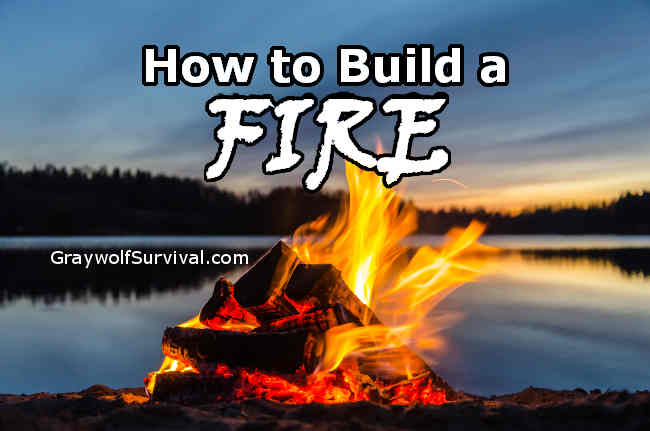 I was out with my friends the other Friday Night, as I am wont to do. It was a beautiful night, and finally down to a temperature cool enough to be able to enjoy a fire. I was watching a friend of mine try to start a fire before everyone came over.
I was out with my friends the other Friday Night, as I am wont to do. It was a beautiful night, and finally down to a temperature cool enough to be able to enjoy a fire. I was watching a friend of mine try to start a fire before everyone came over.
He had a huge pile of crisp, dried-out palm fronds, twigs and some small logs. And lighter fluid. Even with this perfect combination of stuff to make a roaring beast of an inferno that would impress Dante himself, the fire kept going out even after 20 minutes unless he kept dowsing it with that flammable liquid. It wasn’t going well.
To be fair, he’s from a big city and never really got a chance to learn about fires. He’s a great guy, and really smart, but he’d only been camping once in his life, and that was when we all went out as a neighborhood earlier this year when I wrote about the solar power box. That’s when it really dawned on me that something that is pretty common-sense for someone who grew up in the woods and used a wood stove to heat their house like we did. It isn’t so straight-forward to someone who was never taught by someone. Even smart people. It’s more of an art than a science but if you understand a little about the science, you can wing the art. Fake it until you make it, as they say.
So how do you build a fire for a campfire or for survival?
There’s nothing like camping around a campfire, drinking great beer and eating great food with your friends or telling campfire stories to your children. It kinda sucks though if you can’t get the fire started. It’s even worse if you’re trying to start a fire to survive.
You’d think something like this would be pretty easy to learn from reading a book or a website. You actually can, to a point, but to really learn it, you need to learn from an instructor or do a lot of trial and error – and actually do it.
The keys to building a fire are allowing for proper airflow and building the fire in stages with the right fuel. It’s really easy if you understand these key elements. It’s really hard if you don’t.
Unfortunately, I see a lot of information on the web about how to build a fire but almost all of it is just regurgitated crap from sites that stole the information right out of a Boy Scout or Army manual. Those are great for people who have a basic knowledge already but what about the rest who never grew up in the woods or ever had military training?
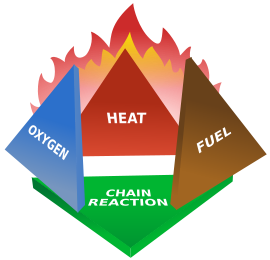
The Fire Tetrahedron
A lot of the more detailed ones go into the Fire Triangle (Fuel, Air, Heat or similar) or something like the Fire Tetrahedron (Fuel, Oxygen, Heat, Chemical Reaction). Because they are pretty technical and not completely accurate (fire doesn’t require air or even oxygen, for example), we’re not gonna go into their ideas. This is a basic post on what you need to know about how to actually build the fire. Of course, to know that, we do need to know a little about how a fire works.
This article is also not going to teach you how to get the fire started. There are as many ways to do that as there are different types of wood and cultures in the world. There are lots of places to learn such as reading this pdf on how to use a bowdrill, this crazy expensive Intro to Combustion book, or actually going to a real-life school to really learn it like the one my friend Travis teaches at the Northwest Survival School. Hell, as far as I’m concerned here today you showed up with a cheap lighter – as you always should.
This is about how to prepare and place what you’re going to burn so that it gets started quicker and burns more easily.
So how does fire work?
A fire is just a chemical reaction that makes heat and light. And sometimes smoke. It’s just the combination of two chemicals that trade electrons, which leaves over some extra energy it gets rid of.
Oxidizer and Fuel
The first two things you need for a fire are Oxidizer and Fuel. For a typical campfire, the oxidizer is air and the fuel is wood.
There’s more though. Obviously. If you leave a piece of wood in the air and nothing else is added to it or changed, it doesn’t automatically catch fire. That would suck. Especially if you’re a tree.
Wood and air aren’t the only fuels/oxidizers either. You could also use combinations like Potassium Permanganate and Glycerine for a fire. It won’t burn for long but boy-howdy will it burn hot. Works even if it’s wet out.
Heat
One of the next things you need is Heat. If you’ve ever tried to start a fire on a cold rock, you realize that it’s pretty difficult. That’s because the reaction requires a certain amount of heat to keep going. Some Fuel/Oxidizer combinations are more affected by the temperature than others. A Fluorine fire, for example, doesn’t much care about the temperature. Nay lass. It’s gonna burn baby burn!
Another reason Heat is such an important piece is that it’s a big reason why wet wood doesn’t burn as well as dry wood. Evaporation requires energy. If wood is wet, the energy that could have been used to keep the chemical reaction going is spent making steam.
Ignition Source
A lot of places combine Ignition Source with either Fuel or Heat. For our purposes, it’s a whole separate entity. For example, you can have a cow fire that was ignited by a lightning bolt from Zeus and extinguished after it fell off a parking structure onto the cold marble floor of a yuppie mall. Zeus was the ignition source, not the cow or the marble. You can also think of the fire itself as the ignition source to keep the fire going.
Surface Area
Why do we care about Surface Area? Because as we learned before, a fire is a chemical reaction. The more two chemicals can touch, the more they’ll react. This is a very important piece of the puzzle. It’s also something that most articles don’t even go over, unless they’re real science-y and then they forget to say it in English.
Things that have more surface area will burn more. This means that for the same amount of that fuel, it will burn hotter and light easier but in most cases, will burn out quicker. This is absolutely a key concept to building a proper fire. Grinding or chopping things up gives it more surface area, or even using some kind of liquid.
Air
The more air you can get to be able to be pulled through the insides of a fire, the better it’ll burn. leaving space between pieces of wood will allow more air between it. This is related to the Surface Area part of the equation since the air in a campfire is part of the chemical reaction. If the wood gets starved of oxygen because another piece near it is burning it up, it’ll starve. Leave gaps.
The components of a well-built fire
Before you can start a fire, you really need to build something that will take and hold a fire well. It doesn’t do much good to go through all the trouble of getting a little coal started if you then have to go gather wood and pile it up. To build it, you need to know what you’re going to pile into it.
A proper fire will be built in layers of dry material with different surface areas and have lots of airflow.
But why?

On the other extreme would be a large, smooth log – especially a large, smooth, wet log. A spark hitting it wouldn’t have a lot to keep it combusting so it just burns out on the surface. The energy that is expended from the reaction doesn’t catch easily to the surrounding wood. On the other hand, one of these would burn for a long time. A wet log will also not burn as well as it does burn so you’ll get more smoke and less heat and light. Smoke is an indication of a fire that isn’t burning efficiently.
The key is to get something started that’s easy to burn and hot and then have that catch something that isn’t quite as easy to catch but burns longer.
There are basically four levels you can think of in a fire:
- Ignition Source
- Tinder
- Kindling
- Fuel Wood
Ignition Source
The thing you use to start a fire, like a spark from a magnesium fire starter (Ignition Source), usually catches Tinder on fire (especially if you’re using something like this for tinder). You can consider an accelerant, such as gasoline or lighter fluid, as either part of the Ignition Source or the Tinder, depending on what you’re trying to catch fire with it. BTW, one helper that is available a lot of times in a survival situation, at least in the U.S., is a bullet. work the lead round back and forth until you can pull it off and you’ll be able to get to the gunpowder inside. Pile that together on something that will keep it from falling through or blow away, put some tinder right next to it, and throw some sparks against it or some focused light with a magnifying glass. It’s one of the ways you can get wet tinder to catch sometimes too.
Tinder
Tinder is an arbitrary designation for something like dry grass or leaves that catch fire easily to burn Kindling.
Kindling
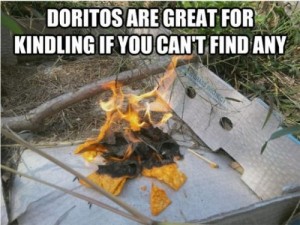 Kindling is something like small twigs that doesn’t usually catch easily enough to be started from your ignition source but it will easily enough if it’s above a pile of burning Tinder or a really hot Ignition Source.
Kindling is something like small twigs that doesn’t usually catch easily enough to be started from your ignition source but it will easily enough if it’s above a pile of burning Tinder or a really hot Ignition Source.
Fuel Wood
Fuel Wood is what you’re trying to get to burn in the long run. Ok, it might not be wood but it’s the big amount of whatever that will keep going without you having to keep messing with it. These would be small logs and big logs.
In most cases, small logs will be what you’ll be burning in a campfire. Large logs are better for keeping the fire going if you’re asleep or away for a while fishing or staring at boobies and won’t be around to tend the fire.
What do you need to know abut the firepit or campfire itself?
There are a lot of ways to build a fire, from using a home-built or purchased rocket stove, a Dakota Fire Hole, to making a traditional campfire. Each is slightly different but all use the ideas from above. I’m just gonna go over a traditional campfire because the theory is easier to understand.
The location
Obviously fire likes to grow. You need to set a fire so it doesn’t start a forest fire set your tent/structure ablaze. You may need to clear an area from dry leaves etc.
If you have a steady breeze from one direction, such as in a small valley, you know which direction the smoke will be going. You don’t want to wake up smelling like smoked meat.
You especially want the fire to keep you warm if you’re using it at night to keep from freezing. Putting you between it and something to reflect the fire will help.
Also, make sure the place you start your fire is near your freaking fire. I don’t know how many times I’ve seen people fire up a tinder bundle and then carry the stupid thing over to where the fire is. Start it within reach. If that’s not possible, then start one fire and move it to a secondary location.
The foundation
As we know, losing heat from the process can kill a fire. Because of this, you don’t want to start a fire on top of a cold rock or wet ground if you can avoid it. Especially if you don’t have any choice but to put a fire where water may pool up or run right through. In these cases, try to build a platform of rocks or something that won’t burn. BTW, you also don’t want to use smooth, round rocks in your fire that could have been part of a riverbed because any trapped water can expand as it turns to steam and explode into your face.
If you have to, pile up rough rocks and dry dirt for the bottom. If there’s a chance of water flowing down into it, you may want to elevate it a bit with a few larger rocks. If you have a way to get air up underneath the fire such as in the case of the Dakota Fire Hole, even better. You want airflow from the sides and bottom as much as possible.
One thing you should try to do is what my dad would have called an ‘old indian trick.’ Instead of making a circle of rocks, make two arcs with the front open and cleared for debris. At the back, stand up a tall rock as wide as the fire if you can. What this will do is pull the air from the front, through the fire, and up the side of that rock. Why do you want to do that? Because it’ll keep the smoke out of our face.
Once you’ve selected a spot and have the right stuff on the bottom, putting large rocks around the fire will not only keep it a little tidier, the rocks will store and give off the heat, keeping you warm longer.
If it’s windy, you’ll want to make a wind break around your fire to get it started. Big rocks or logs work pretty well usually.
The pile
The first thing you want to do is lay down a pile of Tinder. This could be dry grass, paper, cotton balls, cattail fluff or whatever. It’s the stuff that your Ignition Source will easily catch. If you’re starting your fire with some methods, such as by rubbing two sticks together, you’ll have your Tinder as part of your Ignition Source and then transfer it to your pile. Depending on how you’ve built it and how much big or wet your Kindling is, you may want to have Tinder as either the base of your pile or just leave a hole to put the pile you’re bringing from your Ignition Source.
Next comes the Kindling. The easiest way is to lay down a row of twigs on your Tinder, and then lay another row across that row – making a grid. You don’t want the Kindling to smoosh your Tinder down too much though so sometimes it helps to lay a couple of sticks or small logs on to opposite sides of the Tinder and lay the first row on top of that. Then make a teepee of Kindling with the Tinder in the middle. You can also skip the flat rows and go right for the teepee if the size of your pieces don’t lay flat next to each other too well the other way or you don’t have enough pieces. The big thing here is to put the Kindling directly above the Tinder but leave room for a lot of airflow. You can do it all sorts of ways as long as you remember that.
Make a pile of your smaller Fuel Wood right near the fire. You can even stack a few layers of it like a little log cabin (sans roof) to block the wind and make it part of the fire. You’ll at least want a few pieces of wood to lay on your fire once it gets going. Don’t pack your pile down with large pieces of wood that impede your airflow. This should all be ready before you start.

The fire
Once everything is set up, choose your method of starting it and light up your tinder. If you’ve built it correctly, it’ll burn from the center out in all directions. You may need to gently blow on the fire to get it to catch enough to keep itself going.
From this point, you have to adapt to whatever the fire wants. As the fire grows, you may need to either add more Tinder or open up some airflow. You also may need to lay a few more pieces of Kindling. What you’re looking for is a big red pile of glowy goodness.
Once you have a nice pile of red coals going, you can lay down your smaller Fuel Wood if you don’t already have it on the pile. Make sure the Fuel Wood has access to both the flames and outside air if possible. Don’t do this too quickly or it’ll go out.
You should be set now to start your fire under normal circumstances. If it’s damp, things get a lot harder. Here’s a video to give you some hints about that.
You’ll have to check to see if this is still available by the time you read this but check out the Everstrike Match. Works in pretty much any conditions. It’s free right now.
That’s pretty much it. Now go put away the lighter fluid. You’re not gonna need it anymore.



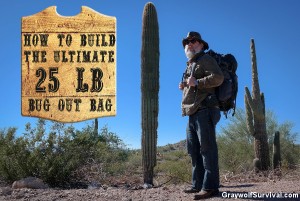

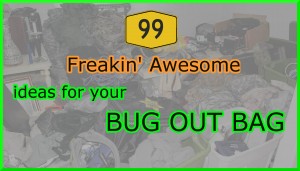
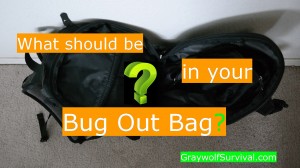

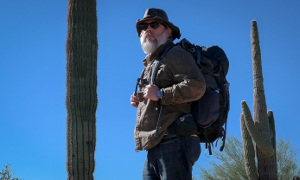
The description of the 2 arcs with the rock in the back is certainly very clear in your mind, but it did not translate well on the page. Would you mind providing a diagram of what you mean? Much appreciated!
Obviously he never reads the comments. I thought the same thing, great idea, poor description.
Great help with your response, John.
I agree, but I don’t have a diagram that I’m allowed to show. Basically, you need a flat rock on one end of the fire, standing straight up and hopefully downwind of the fire, but don’t bet on that staying that way. It’s like a tombstone. The arcs are made basically by making a circle with the flat rock on one end and an open area on the other. That allows air to be pulled in from the opening, into the fire, and to hit the flat rock, which has no way to travel but straight up.
In other words. make a normal circle with rocks. On one end, put a flat rock like a tombstone. On the other end, move a few rocks out of the way to pull in cool air into the fire.
Let me know if that’s still not clear but keep in mind it’s not an exact science anyway so there’s no really right way to do it.